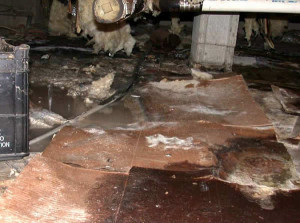A homeless shelter located in a church basement had a linoleum floor laid over plywood. In humid weather, one corner of the floor bulged, and in other areas, “bumps” appeared in the linoleum. Yet there had never been any flooding or leakage in that area. Leak-testing and observation with a borescope of the area between the plywood and the cement slab beneath did not reveal any signs of water intrusion from the adjacent crawl space. I did, however, see damaged and loosened seams between sections of the linoleum. The floor was mopped four times a week, and excess water was used. The water loosened the seams and penetrated beneath the linoleum and into the plywood. The seams and loose flooring had to be repaired, and a drier floor-cleaning technique used.

The homeless shelter described in this case study was fortunate because there was no water in the crawl space. Other owners with crawl spaces are less fortunate. Because these spaces are rarely inspected, serious conditions can persist and lead to significant pest, mold and rot problems. The photo depicts water and moldy debris in a crawl space under a commercial kitchen that had a drainpipe leak. Despite the moldering mess beneath the kitchen floor, the cuisine was great.
© 2025 Jeffrey C. May, M.A.
